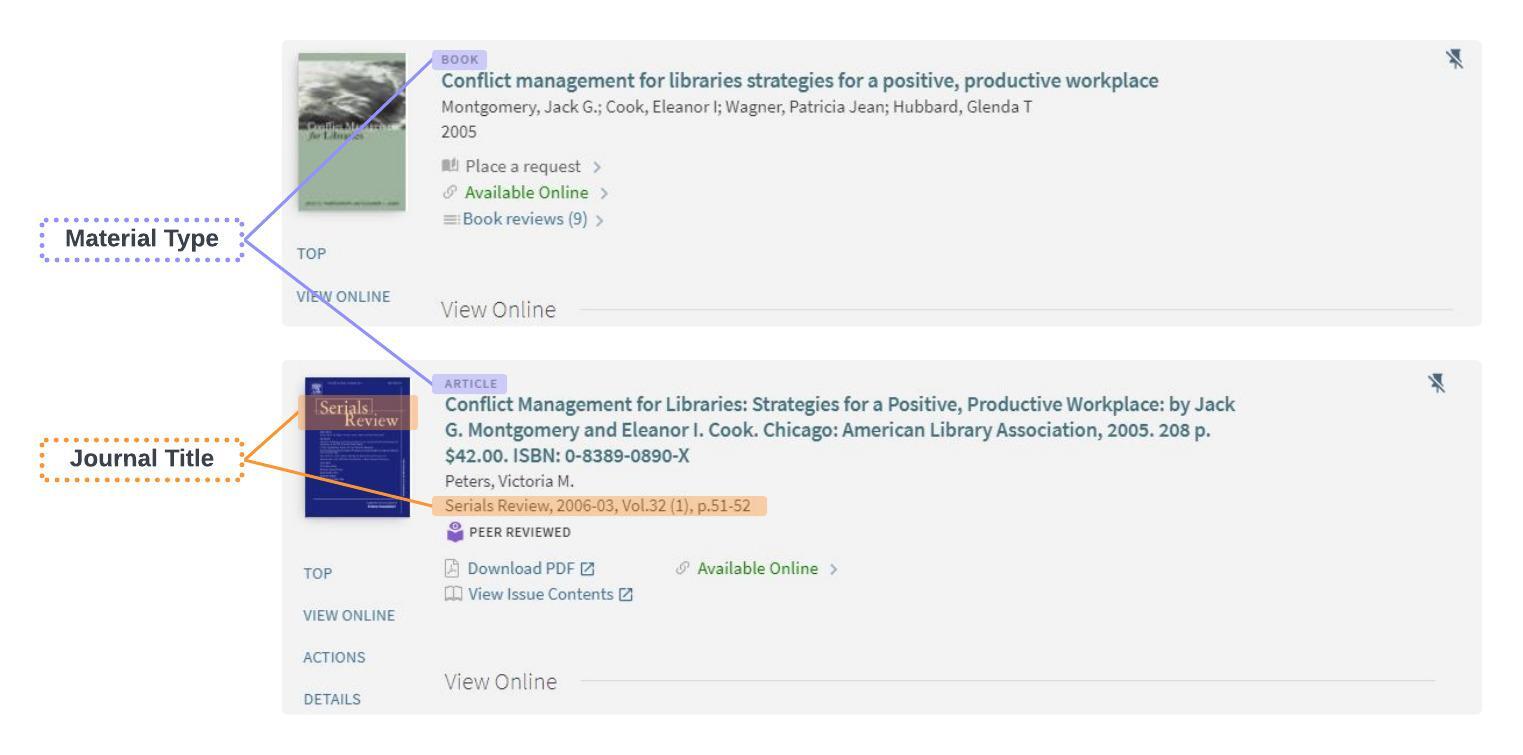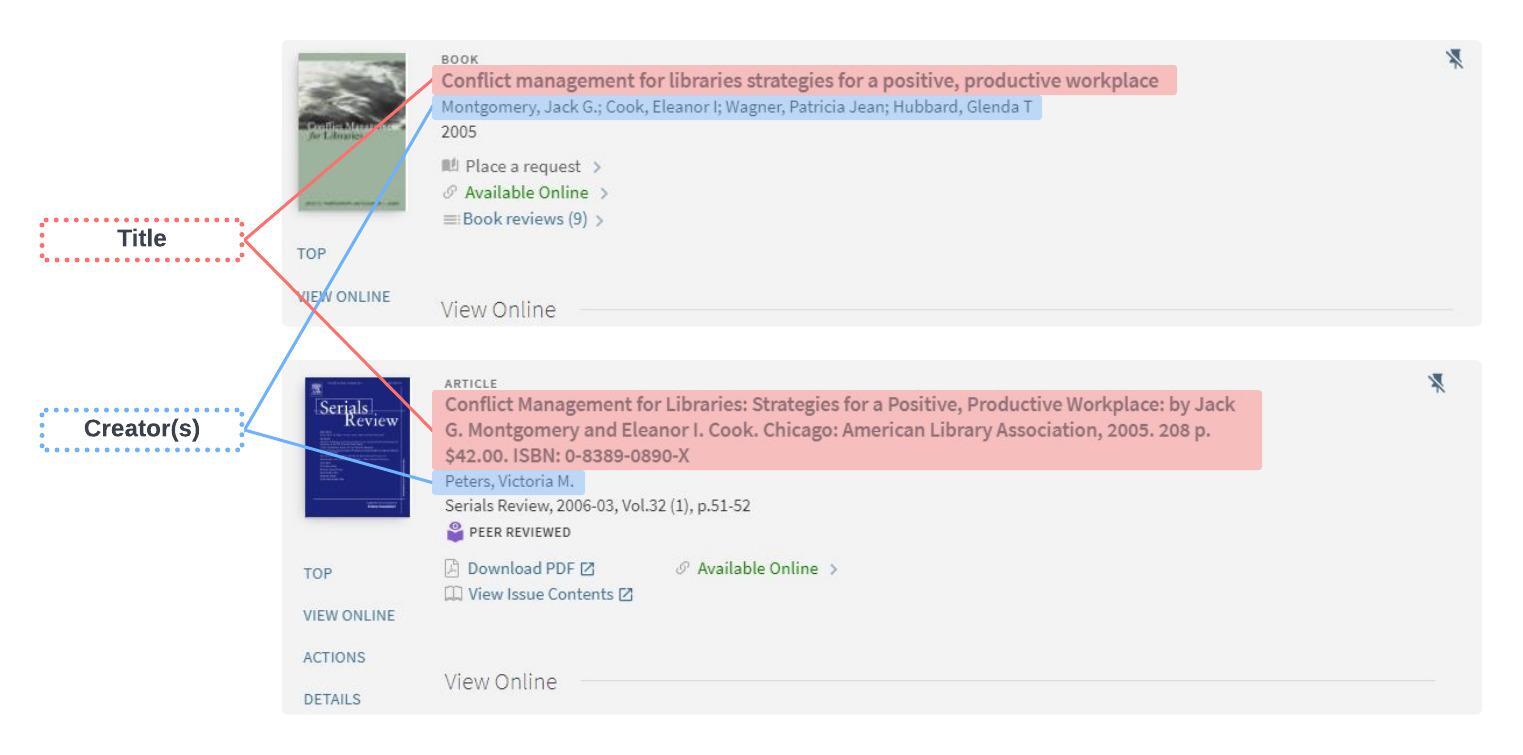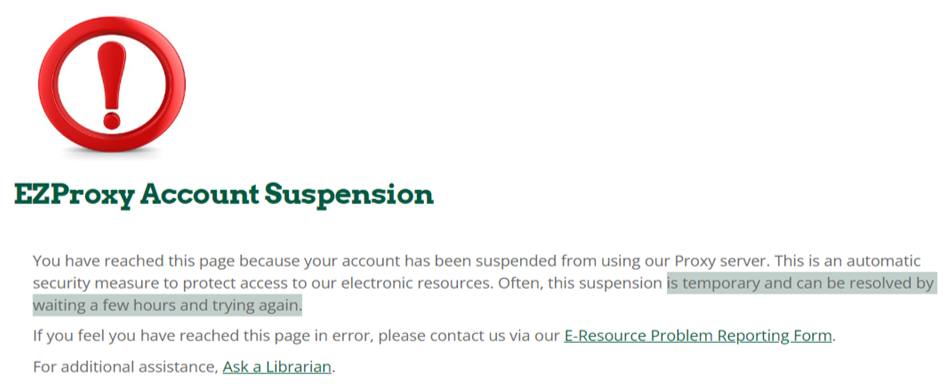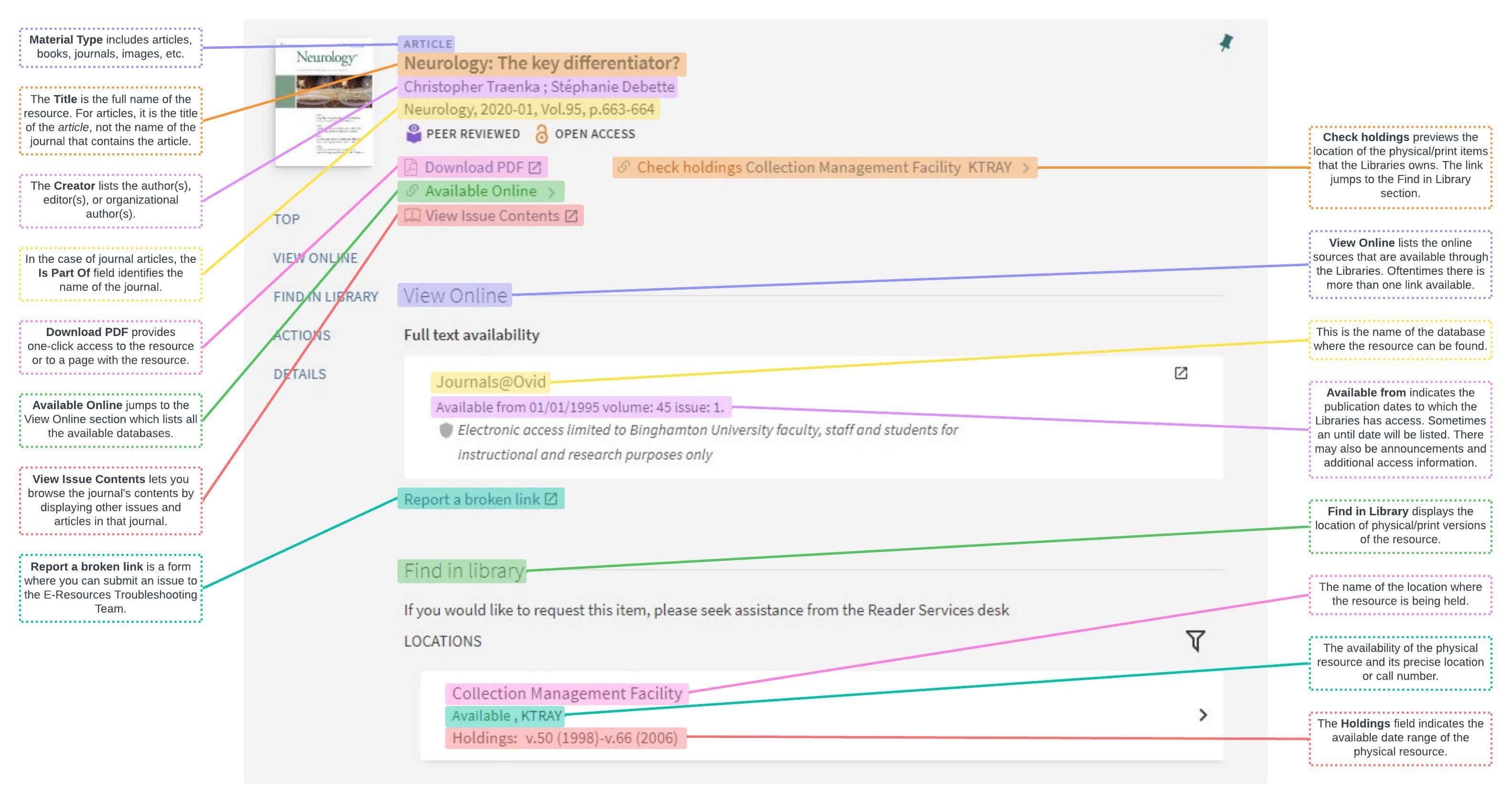If you're experiencing problems accessing an e-resource through Find It! or otherwise, this page contains solutions to the most common issues. For help with borrowing resources or technical help other than e-resources, please complete the Technical Problems Reporting Form or contact Reader Services.
Most Common Problems
I am getting an error (e.g. Page not found, 404 Bad Request, etc).
I only see the abstract or citation.
The site prompted me to pay for access.
I am locked out of viewing the book.
The link went to the database instead of the article I wanted.
Analyzing an Entry in Find It!
E-Resources with Limited Access
You may see a note within Find It! next to a shield icon that reads, "Electronic access limited to Binghamton University faculty, staff and students for instructional and research purposes only." These proxied resources include subscribed databases, e-journals, e-books, and other e-resources that are restricted by license agreements for the purposes of research, teaching, and private study. They are available on-campus and current Binghamton faculty, staff, and students can access them off-campus by logging in with your BU Computer Account. Guest users are not given access to subscribed library resources from off-campus as this violates the license agreements with the database providers.
Acceptable use of these resources can be found on the following policy pages: Binghamton University Copyright Policy and Binghamton University Computer and Network Policy.
Common Problems & Possible Solutions
Problem: I am getting an error (e.g. Page not found, 404 Bad Request, 504 Gateway Error, etc).
- Solution #1: Try another link. Sometimes a single resource is available through multiple sources or databases. If you tried one link and could not access the resource, try all the subsequent links; at least one of them should direct you to the resource you are looking for. You can try the Download PDF link that may appear at the top of the entry, or there may be several databases listed under the View Online section (for the location of various sections in an entry, see Analyzing an Entry in Find It!).
- Solution #2: Clear your browser’s cache and cookies. Clear your browsing data and reload the page. Oftentime this can resolve many issues. The exact steps to do this will depend on your browser; see the Information Technology Services (ITS) page on How to Clear Web Browser Cache for a step-by-step explanation.
- Solution #3: Update your current browser. An outdated browser can result in unexpected glitches, and performing an update may solve your problem. The exact steps will depend on your browser. Typically update information is kept under Help and/or About.
- Solution #4: Try another browser. Sometimes there are unexpected conflicts with your web browser and using a different one can help. For example, if you are using Google Chrome, try Firefox or Microsoft Edge instead.
- Solution #5: Search by the journal title. Complications can arise with direct linking to a resource. If you are looking for an article, try searching for the title of the journal instead of the title of the article. Once you find the journal, search for the article within the database. Also try searching for keywords within the article title as opposed to the full article title because sometimes the entry can be off.
- Solution #6: Submit a “Report a broken link” form. If you still cannot access the resource after trying the steps above, click the link in Find It! labeled “Report a broken link” (for the location of various sections in an entry, see Analyzing an Entry in Find It!). Submit the form and our E-Resources Troubleshooting Team will get back to you. Alternatively, you may contact the team directly at ertt@binghamton.libanswers.com.
Problem: I only see the abstract or citation. I can’t get the full article/book!
- Solution #1: Check if the resource is a review. Look for words such as review, survey, summary, or analysis. If none of these words
appear, double-check the Material Type, e.g. book, article, and so on (for the location of various sections in an entry,
see Analyzing an Entry in Find It!). For example, if you are searching for a book but the Material Type says ARTICLE, then the article is likely a review of the book as opposed to the full
book. The following two images show the Find It! entries for a book titled, "Conflict
management for libraries" and a review article of the book, respectively.
 We know the review is not the full book because its Material Type is labeled ARTICLE. Another clue can be found in the title of the journal, which is Serials Review.
We know the review is not the full book because its Material Type is labeled ARTICLE. Another clue can be found in the title of the journal, which is Serials Review. - Solution #2: Do an Advanced Search and/or filter by the Material Type. Try an Advanced Search and filter the Material Type to only search for the type of resource you are looking for, e.g. books, articles, journals, and so on. If you are looking for a book, the filtering will exclude any articles about the book.
- Solution #3: Verify that the citation of the resource matches what you are looking
for. For example, if the resource is a book review instead of the actual book, the author
of the review will be different from the author of the book. In the images below,
the authors of the book (e.g. Montgomert, Jack G., et al.) are listed in the Title field of the article while the Creator of the article is a different person.

- Solution #4: Search by the journal title or ISSN. Complications can arise with direct linking to a resource. If you are looking for an article, try searching for the journal title instead of the title of the article. Once you find the journal, search for the article within that database.
- Solution #5: Submit a “Report a broken link” form. If you still cannot access the resource after trying the steps above, click the link in Find It! labeled “Report a broken link” (for the location of various sections in an entry, see Analyzing an Entry in Find It!). Submit the form and our E-Resources Troubleshooting Team will get back to you. Alternatively, you may contact the team directly at ertt@binghamton.libanswers.com.
Problem: The site prompted me to pay for access.
- Solution #1: Check the dates of coverage. Sometimes the Libraries only has access to journal issues within a specific timeframe. The dates of coverage will be indicated below the name of the database in the View Online section (for the location of various sections in an entry, see Analyzing an Entry in Find It!). For example, if the text says "Available from 01/01/1995 until 12/31/2020", then the Libraries only has access to articles that were published between those dates. If you need a resource outside of those dates, you may request it through Interlibrary Loan (ILL).
- Solution #2: Check the publication date of the resource. Sometimes a resource may list a digitization date instead of the original publication date; this can happen for old resources that were previously print-only. If you know a journal has been in publication since the 1950s but the date for Volume 2 says 2020, this is a clue that there may be an error in the metadata. Furthermore, the original publication date must fall within the Libraries' dates of coverage, as mentioned in Solution #1: Check the dates of coverage.
- Solution #3: Make sure you are logged into your Bmail account. If you are on-campus, logging into your account will give you access to the Libraries' subscriptions. If you are off-campus, sign in at https://ssl.binghamton.edu or view the Information Technology Services (ITS) page on Connecting from Off-Campus.
- Solution #4: Submit a “Report a broken link” form. If you still cannot access the resource after trying the steps above, click the link in Find It! labeled “Report a broken link” (for the location of various sections in an entry, see Analyzing an Entry in Find It!). Submit the form and our E-Resources Troubleshooting Team will get back to you. Alternatively, you may contact the team directly at ertt@binghamton.libanswers.com.
Problem: I am locked out of viewing the book.
- Solution #1: Clear your browser’s cache and cookies. Clear your browsing data and reload the page. Oftentimes this can resolve many issues. The exact steps will depend on your browser; see the Information Technology Services (ITS) page on How to Clear Web Browser Cache for a step-by-step explanation.
- Solution #2: Check how many users are allowed at one time. Some e-books are Single User; this means that at any given moment, only one user may access the e-book. This information can be found below the name of the database in the View Online section (for the location of various sections in an entry, see Analyzing an Entry in Find It!). If the book says Single User, try to access the book 2-3 hours later as the other user may have finished by then.
- Solution #3: Review the guide on Finding and using e-books. If the solutions above do not fix your problem, you can check the Finding and using e-books subject guide. This page details how to view and/or download an e-resource for specific databases.
- Solution #4: Submit a “Report a broken link” form. If you still cannot access the resource after trying the steps above, click the link in Find It! labeled “Report a broken link” (for the location of various sections in an entry, see Analyzing an Entry in Find It!). Submit the form and our E-Resources Troubleshooting Team will get back to you. Alternatively, you may contact the team directly at ertt@binghamton.libanswers.com.
Problem: The link went to the database instead of the article I wanted.
- Solution #1: Search for the article within the database. Some databases do not allow direct linking to articles or journals, such as NexisUni, Westlaw, or Korean Studies Information Service System (KISS). If you are directed to the database instead of the particular resource you are looking for, search for that item within the database.
- Solution #2: Submit a “Report a broken link” form. If you still cannot access the resource after trying the steps above, click the link in Find It! labeled “Report a broken link” (for the location of various sections in an entry, see Analyzing an Entry in Find It!). Submit the form and our E-Resources Troubleshooting Team will get back to you. Alternatively, you may contact the team directly at ertt@binghamton.libanswers.com.
Problem: The link went to a completely different website.
- Solution #1: Try another link. Sometimes a single resource is available through multiple sources or databases. If you tried one link and could not access the resource, try all the subsequent links; at least one of them should direct you to the resource you are looking for. You can try the Download PDF link that may appear at the top of the entry, or there may be several databases listed under the View Online section (for the location of various sections in an entry, see Analyzing an Entry in Find It!).
- Solution #2: Do a Google search for Open Access resources. For Open Access resources (i.e. resources which are available online for free), the
resource may be accessible on Google Scholar or a similar platform. If you are unsure
whether the resource is Open Access, search for the orange opened lock icon in Find
It. The opened lock is a universal symbol for Open Access.

- Solution #3: Submit a “Report a broken link” form. If you still cannot access the resource after trying the steps above, click the link in Find It! labeled “Report a broken link” (for the location of various sections in an entry, see Analyzing an Entry in Find It!). Submit the form and our E-Resources Troubleshooting Team will get back to you. Alternatively, you may contact the team directly at ertt@binghamton.libanswers.com.
Problem: The PDF is blank or missing pages.
- Solution #1: Clear your browser’s cache and cookies. Clear your browsing data and reload the page. Oftentimes this can resolve many issues. The exact steps will depend on your browser; see the Information Technology Services (ITS) page on How to Clear Web Browser Cache for a step-by-step explanation.
- Solution #2: Update your current browser. An outdated browser can result in unexpected glitches, and performing an update may solve your problem. The exact steps will depend on your browser. Typically update information is kept under Help and/or About.
- Solution #3: Try another browser. Sometimes there are unexpected conflicts with your web browser and using a different one can help. For example, if you are using Google Chrome, try Firefox or Microsoft Edge instead.
- Solution #4: Check your internet connection. Sometimes PDFs take time to load. If your connection is slow or lagging, this may take longer than usual.
- Solution #5: Look for the navigation buttons in the PDF viewer. There are many different kinds of embedded PDF viewers, each with their own navigation layouts and buttons. The navigation bar which lets you view the different pages of the document can be anywhere in the viewer, but some common locations are above or below the PDF display. Search for a scrollbar to the right of the PDF, or search for left and right arrows keys that may allow you to flip through the pages.
- Solution #6: Submit a “Report a broken link” form. If you still cannot access the resource after trying the steps above, click the link in Find It! labeled “Report a broken link” (for the location of various sections in an entry, see Analyzing an Entry in Find It!). Submit the form and our E-Resources Troubleshooting Team will get back to you. Alternatively, you may contact the team directly at ertt@binghamton.libanswers.com.
Problem: I was told that my account was suspended.
- Solution #1: Wait and try again later. You might see an EZproxy Account Suspension error message such as in the image below.
This can happen if you are trying to access a particularly large PDF file. If you
see this error message or something similar, wait for 2-3 hours and try to access
the resource again.

- Solution #2: Submit a ticket to the Libraries Systems Department. If waiting and trying again later does not work, contact the Libraries at libsys@binghamton.edu. Include information about the resource you are trying to access and whether you are on-campus or off-campus.
